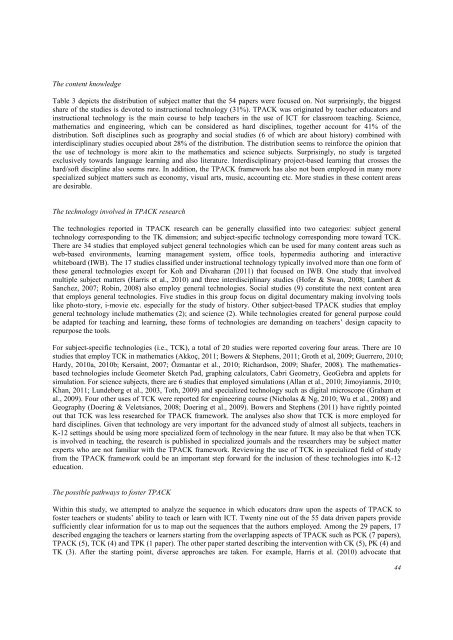Download Complete Issue in PDF - Educational Technology & Society
Download Complete Issue in PDF - Educational Technology & Society
Download Complete Issue in PDF - Educational Technology & Society
Create successful ePaper yourself
Turn your PDF publications into a flip-book with our unique Google optimized e-Paper software.
The content knowledge<br />
Table 3 depicts the distribution of subject matter that the 54 papers were focused on. Not surpris<strong>in</strong>gly, the biggest<br />
share of the studies is devoted to <strong>in</strong>structional technology (31%). TPACK was orig<strong>in</strong>ated by teacher educators and<br />
<strong>in</strong>structional technology is the ma<strong>in</strong> course to help teachers <strong>in</strong> the use of ICT for classroom teach<strong>in</strong>g. Science,<br />
mathematics and eng<strong>in</strong>eer<strong>in</strong>g, which can be considered as hard discipl<strong>in</strong>es, together account for 41% of the<br />
distribution. Soft discipl<strong>in</strong>es such as geography and social studies (6 of which are about history) comb<strong>in</strong>ed with<br />
<strong>in</strong>terdiscipl<strong>in</strong>ary studies occupied about 28% of the distribution. The distribution seems to re<strong>in</strong>force the op<strong>in</strong>ion that<br />
the use of technology is more ak<strong>in</strong> to the mathematics and science subjects. Surpris<strong>in</strong>gly, no study is targeted<br />
exclusively towards language learn<strong>in</strong>g and also literature. Interdiscipl<strong>in</strong>ary project-based learn<strong>in</strong>g that crosses the<br />
hard/soft discipl<strong>in</strong>e also seems rare. In addition, the TPACK framework has also not been employed <strong>in</strong> many more<br />
specialized subject matters such as economy, visual arts, music, account<strong>in</strong>g etc. More studies <strong>in</strong> these content areas<br />
are desirable.<br />
The technology <strong>in</strong>volved <strong>in</strong> TPACK research<br />
The technologies reported <strong>in</strong> TPACK research can be generally classified <strong>in</strong>to two categories: subject general<br />
technology correspond<strong>in</strong>g to the TK dimension; and subject-specific technology correspond<strong>in</strong>g more toward TCK.<br />
There are 34 studies that employed subject general technologies which can be used for many content areas such as<br />
web-based environments, learn<strong>in</strong>g management system, office tools, hypermedia author<strong>in</strong>g and <strong>in</strong>teractive<br />
whiteboard (IWB). The 17 studies classified under <strong>in</strong>structional technology typically <strong>in</strong>volved more than one form of<br />
these general technologies except for Koh and Divaharan (2011) that focused on IWB. One study that <strong>in</strong>volved<br />
multiple subject matters (Harris et al., 2010) and three <strong>in</strong>terdiscipl<strong>in</strong>ary studies (Hofer & Swan, 2008; Lambert &<br />
Sanchez, 2007; Rob<strong>in</strong>, 2008) also employ general technologies. Social studies (9) constitute the next content area<br />
that employs general technologies. Five studies <strong>in</strong> this group focus on digital documentary mak<strong>in</strong>g <strong>in</strong>volv<strong>in</strong>g tools<br />
like photo-story, i-movie etc. especially for the study of history. Other subject-based TPACK studies that employ<br />
general technology <strong>in</strong>clude mathematics (2); and science (2). While technologies created for general purpose could<br />
be adapted for teach<strong>in</strong>g and learn<strong>in</strong>g, these forms of technologies are demand<strong>in</strong>g on teachers’ design capacity to<br />
repurpose the tools.<br />
For subject-specific technologies (i.e., TCK), a total of 20 studies were reported cover<strong>in</strong>g four areas. There are 10<br />
studies that employ TCK <strong>in</strong> mathematics (Akkoç, 2011; Bowers & Stephens, 2011; Groth et al, 2009; Guerrero, 2010;<br />
Hardy, 2010a, 2010b; Kersa<strong>in</strong>t, 2007; Özmantar et al., 2010; Richardson, 2009; Shafer, 2008). The mathematicsbased<br />
technologies <strong>in</strong>clude Geometer Sketch Pad, graph<strong>in</strong>g calculators, Cabri Geometry, GeoGebra and applets for<br />
simulation. For science subjects, there are 6 studies that employed simulations (Allan et al., 2010; Jimoyiannis, 2010;<br />
Khan, 2011; Lundeberg et al., 2003, Toth, 2009) and specialized technology such as digital microscope (Graham et<br />
al., 2009). Four other uses of TCK were reported for eng<strong>in</strong>eer<strong>in</strong>g course (Nicholas & Ng, 2010; Wu et al., 2008) and<br />
Geography (Doer<strong>in</strong>g & Veletsianos, 2008; Doer<strong>in</strong>g et al., 2009). Bowers and Stephens (2011) have rightly po<strong>in</strong>ted<br />
out that TCK was less researched for TPACK framework. The analyses also show that TCK is more employed for<br />
hard discipl<strong>in</strong>es. Given that technology are very important for the advanced study of almost all subjects, teachers <strong>in</strong><br />
K-12 sett<strong>in</strong>gs should be us<strong>in</strong>g more specialized form of technology <strong>in</strong> the near future. It may also be that when TCK<br />
is <strong>in</strong>volved <strong>in</strong> teach<strong>in</strong>g, the research is published <strong>in</strong> specialized journals and the researchers may be subject matter<br />
experts who are not familiar with the TPACK framework. Review<strong>in</strong>g the use of TCK <strong>in</strong> specialized field of study<br />
from the TPACK framework could be an important step forward for the <strong>in</strong>clusion of these technologies <strong>in</strong>to K-12<br />
education.<br />
The possible pathways to foster TPACK<br />
With<strong>in</strong> this study, we attempted to analyze the sequence <strong>in</strong> which educators draw upon the aspects of TPACK to<br />
foster teachers or students’ ability to teach or learn with ICT. Twenty n<strong>in</strong>e out of the 55 data driven papers provide<br />
sufficiently clear <strong>in</strong>formation for us to map out the sequences that the authors employed. Among the 29 papers, 17<br />
described engag<strong>in</strong>g the teachers or learners start<strong>in</strong>g from the overlapp<strong>in</strong>g aspects of TPACK such as PCK (7 papers),<br />
TPACK (5), TCK (4) and TPK (1 paper). The other paper started describ<strong>in</strong>g the <strong>in</strong>tervention with CK (5), PK (4) and<br />
TK (3). After the start<strong>in</strong>g po<strong>in</strong>t, diverse approaches are taken. For example, Harris et al. (2010) advocate that<br />
44

















